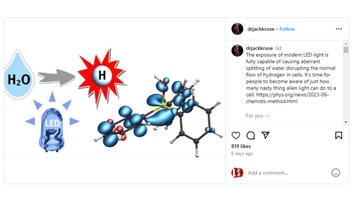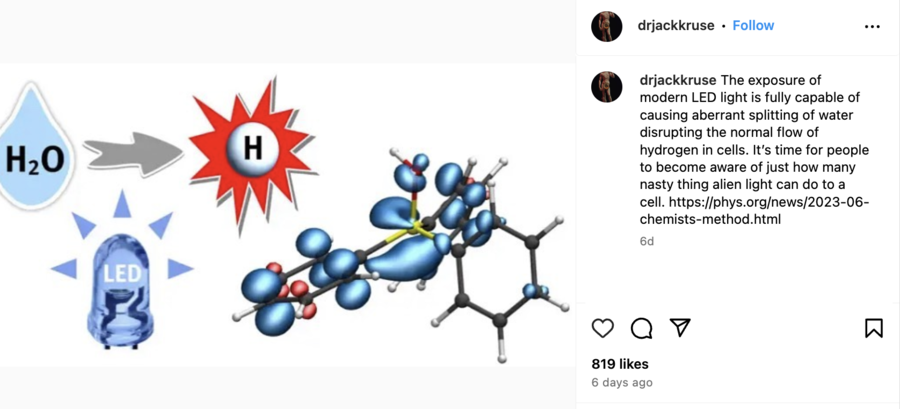
Does exposure to LED lights "disrupt the flow of hydrogen" in the human body, causing harm, as was suggested in a post on Instagram? No, that's not true: The post cited a 2023 study that examined techniques used for water splitting, a green energy industry technology that converts water into hydrogen and oxygen. The findings of this study are unique to a laboratory and not transferable to human health, the study authors confirmed to Lead Stories. Furthermore, the light emitting diodes used in the cited study are not those typically used in commercial or residential lights, a lighting expert told Lead Stories.
The claim originated in a post shared on Instagram on January 19, 2024 (archived here) with a caption that read:
The exposure of modern LED light is fully capable of causing aberrant splitting of water disrupting the normal flow of hydrogen in cells. It's time for people to become aware of just how many nasty thing alien light can do to a cell. https://phys.org/news/2023-06-chemists-method.html
This is what the post looked like at the time of writing:
(Source: Instagram screenshot taken Thurs Jan 25 23:00:31 UTC 2024)
Cited in the above post is a link to a June 28, 2023, news release (archived here) titled "Chemists develop new method for water splitting" announcing a study by researchers at the University of Munster in Germany. (The same press release [archived here] was also posted to the university's official website.) That study was published in the peer-reviewed journal Nature and titled, "Photocatalytic phosphine-mediated water activation for radical hydrogenation" (archived here).
The post on Instagram implies that water-splitting technology could similarly split hydrogen or water in human bodies to disrupt "the normal flow of hydrogen in cells." This is not an accurate reflection of the study findings, its author, Armido Studer, (archived here) confirmed to Lead Stories.
Furthermore, "there's no clear evidence that the findings are translatable to humans," Brandon Baxley, a research and development manager for a Los Angeles-based lighting manufacturer with a background in physics, told Lead Stories.
What is water splitting?
Water splitting is a type of artificial photosynthesis (archived here) that involves transforming water into hydrogen gas, which can then be used in renewable energy. To split water means to break the bonds of a hydrogen atom off a water molecule. In the case of this study, this was done using photocatalytic processes that involve photons, or light energy.
What are LED lights?
LED stands for light emitting diode (archived here), according to Energy Star, the government-backed symbol for energy efficiency. LEDs are different from other conventional lightbulbs, such as incandescent or compact fluorescent lamp (CFL), in that they emit more blue light in a shorter wavelength in a specific direction rather than all directions, providing for more efficient lighting overall.
Study tested new method for water splitting
Contrary to what the post on Instagram suggested, the purpose of the study was not solely focused on LED's role in water splitting.
At the core of their study, researchers identified a new, potentially more viable catalyst for photocatalytic water splitting methods: splitting as the result of light energy, in this case, specific kinds of light emitting diodes.
Because the bonds in water are strong, water must first be activated by a catalyst so that it can react more easily to splitting. In this study, researchers used triaryl phosphines as the catalyst to activate the water used. The research concluded that certain wavelengths of blue light do have enough energy to do this consistently when hitting water in a solution with the specific catalyst used in the study -- but this is a highly specific, uniquely designed scenario.
'No clear evidence that the findings are translatable to humans'
There is no evidence that LED light in its conventional form would have the same effect when directly exposed to water or the human body.
"I confirm that with a blue LED [alone], one cannot split water," Studer confirmed to Lead Stories in an email received on January 25, 2024. "Blue LED does not activate water, the blue light just penetrates through water without any action."
That's because, as is noted in the study, water needs to first be activated by a catalyst to weaken its bonds, allowing for it to be split. In a natural setting, such as in the human body, water is far more complex.
"Water in our bodies isn't pure water - it's combined in solution with many other molecules/minerals/proteins, etc.," Baxley told Lead Stories in an email received on January 25, 2024.
Because water in the human body is made up of many components, the concentration of water that this light would hit in the human body "would be completely different than in the study."
Furthermore, the type of LEDs used for this study are not typically used for general illumination in commercial or residential buildings, Baxley added.
Health concerns related to LED exposure
While the findings of this study cannot be extrapolated to indicate that LED can cause hydrogen in humans to split, it should be noted that there is concern that LED lights may impact human health.
"LEDs of high intensity and high energy can of course damage, for example, eyes, as every light source does. Do not forget that too much sun exposure causes damage to humans!" Studer told Lead Stories.
LED exposure can result in headaches, eye strain and fatigue, according to 2017 research published by the International Journal of Sustainable Lighting (archived here). Similarly, a 2014 study published in Environmental Health Perspectives (archived here) and a 2020 study published in Health Physics (archived here) found that exposure to LED lighting can potentially cause retinal cell damage under high and lengthy exposure conditions -- though again this cannot be translated to typical use in humans. It is also thought that blue light from LED exposure can impact melatonin production (archived here), affecting circadian rhythms in the body that influence sleep cycles.
That being said, exposure to the total amount of blue light from indoor LED lighting is still less than the total amount of blue light from sun exposure, according to an article published by the Illuminating Engineering Society (archived here).
"Any exposure to optical radiation from LEDs, however, is likely to be insignificant compared with exposure to natural light outdoors," concluded the findings of a public health report (archived here) published by the European Commission.
Additional Lead Stories fact checks of claims related to health can be found here.















